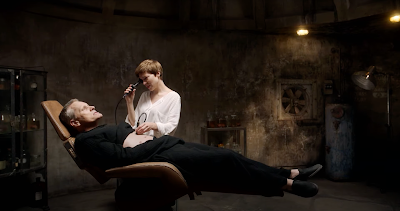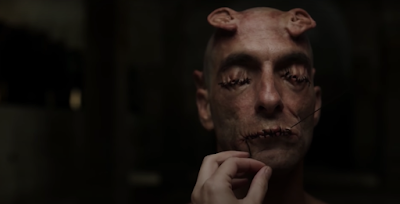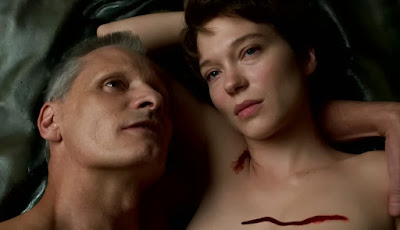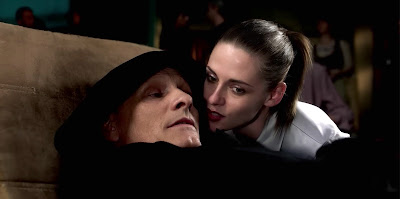There's a sense of the world moving on in David Cronenberg's new film, Crimes of the Future (2022). A lot of Cronenberg's films seem like they depict a world on the brink of collapse, but this one seems like it takes place afterwards, rather than on the brink. The director has watched the world tumble over the falls in the decade since his last movie, precipitated by many of the very things that make up the unease and horror in his earlier films: a pandemic, right wing conspiracies, unfettered capitalism, a brain-washing media landscape. The various apocalypses postulated in the director's earlier films are a fait accompli at the present historical moment. In Crimes of the Future the director says, "yeah, all that happened and this is the result: a world in which no one can feel anything anymore. "
The plot of Crimes of the Future follows performance artists Saul Tenser and Caprice. Saul is on the cutting edge of a brave new world: he produces new organs and the art that he and Caprice make is a show of removing them for an audience. Lately, the government has been stepping in to register new organs, to make sure that what constitutes "human" doesn't drift too far off model. They've created a department to regulate this, the National Organ Registry, a sub-department of the Department of New Vice, which polices bio-crime. When Saul grows his current new organ, he and Caprice go to register at the NOR's local office, where they meet Wippet and Timlin, the bureaucrats in charge. Both of them are fans of Saul's work. Timlin's job is to tattoo new organs for registration. Wippet handles the paperwork. He's also organizing a show of "Inner Beauty" and he wants Saul as the headliner. Saul and Caprice, meanwhile, have their own problems: the special bed that keeps Saul comfortable as he grows new organs is malfunctioning and he's having trouble eating, perhaps as a result of his body's inner changes, perhaps as a result of the technology that supports him. They also have a new show to prepare, so they bring in mechanics from the manufacturer to adjust things. The mechanics discover that Saul and Caprice also have a SARK, a surgical bed that is out of production, which they use in their shows. They're envious and want to examine it. They all convene in the audience for Saul and Caprice's new show, where an aroused Timlin whispers to Saul that surgery is the new sex. Also in attendance is Lang Dotrice, whose wife has suffocated his son because he cannot eat food, only plastic. Lang is the leader of a resistance group who have modified themselves to eat plastic as a next stage in human evolution, but Lang's son, Brecken it seems was born with the ability. He approaches Saul to stage Brecken's autopsy as a show, as propaganda for his organization. But Saul has a secret. He is a covert operative for the Department of New Vice, and his controller views Lang's offer as a means of infiltrating his group...
As I say, there's an apocalyptic ambience laced throughout Crimes of the Future. It's a film that feels like it takes place in the same post-apocalyptic landscape as eXistenZ, only a few years further on. The technology in Crimes looks like an evolution of the tech in that film, and furthers Cronenberg's long project of examining the borderlands between biology and technology. The controller for the SARK module, for example, might be a descendant of eXistenZ's game pods. Some of the other props--particularly Saul's breakfast chair--look to have been constructed from the carcasses of mugwumps. Cronenberg has been working with production designer Carol Spier since the 1970s, so the continuity of design is not unexpected.
In other ways, the film is a break from the director's previous work. Shot in Greece rather than in Cronenberg's usual Toronto haunts, it has a different light than his previous films. This is an effect amplified by being shot by someone other than Peter Suschitsky (it was shot by Douglas Koch). The composition and lighting of the frame have a subtly different look to them, particularly in the way it aestheticizes the ruins of capitalism. There is a motif of derelict ships in this film that ties it to the derelict wasteland at the end of Videodrome. In this film it looks a lot like the ruins of empire one sees in epic paintings of the 19th century. Part of this is the light. Part of this is the happenstance of photogenic wrecks. Part of it is the tone of the film, which instead of being a vivid and angry portrait of the collapse in all its grotty aesthetic blight, is rather a sense of, I don't know, resignation. The film seems positively serene at times.
The absence of some of the director's other usual collaborators are less obvious. The overall pace and rhythm of the film feels unchanged from Cronenberg's previous films, so the departure of editor Ronald Sanders is relatively seamless. Perhaps the most important returning artist is composer Howard Shore, whose score is a relative of the music he wrote for Crash all those years ago. It's an arresting piece of music.
Cronenberg has had access to astonishing actors since the early 1980s and even in a current filmmaking climate that is inimical to filmmaking that isn't going to gross a gajillion dollars opening weekend, he's still able to attract actors who are on board with his weirdness. This is Viggo Mortensen's fifth collaboration with the director, and Cronenberg knows what Mortensen can give him. The two wild cards are Léa Seydoux and Kristen Stewart. Seydoux is unusual in Cronenberg's filmography in so far as she gives one of the least theatrical performances. Her Caprice is warm and complicated even when she engages in the weird science of the film's plot. She adds a touch of glamour, too, particularly in the performance art scenes, that provide the "it" quality of a by-god movie star. That's not something that Cronenberg has indulged much in the past, if at all. Stewart, by contrast, is very much a Cronenbergian character. Her performance as Timlin is a bundle of neurotic mannerisms and tics. Stewart can be a movie star in her own right, but she doesn't turn on that part of her persona in this film at all. In some ways, she's doing the same kind of things her Twilight co-star, Robert Pattinson, did when HE worked for Cronenberg. Down the cast list from the movie stars one finds a pair of performances by Tanaya Beatty and Nadia Litz as the perky repair techs/assassins who get it on in Saul and Caprice's surgical casket. They remind me a bit of the two gay assassins in Diamonds Are Forever, but I can't quantify that association in the actual text of the film, so make of that what you will. Seydoux's performance isn't the only un-Cronenberg-y performance in the film. Lihi Kornowski's scenes as Brecken's mother are naturalistic in comparison to the characters around her. It's a good cast, and they prop up the film's ideas by committing to them fully. Cronenberg has always been good at getting his actors to buy into his private obsessions.
In the run-up to the film's debut at Cannes, in which the director himself fueled speculation about the film when he said that he expected walkouts, a narrative has evolved that this is Cronenbeg's return to the body horror films of his early career. I don't think that's quite right. The thematic preoccupations in the foreground are echoes of late films. There is an emphasis on the fusion of mind and body and art that plays to my mind more like Cosmopolis or eXistenz, though it's a theme that's as old as Scanners. In this film, it ties in more closely with the idea of what it means to be human. Human beings extend themselves by hacking their biology either with more biology or with technology, but this film suggests that they extend themselves with art, as well. The characters in this film have turned the act of hacking their bodies (or hacking up their bodies, as the case may be) into performance. This goes hand in hand with the odd theatrical performances Cronenberg elicits from most of his cast. There is a layered meta textual commentary on the making of his own films here, I think, that suggests that the director himself is venting his spleen in the same way that his actors are shown venting theirs. This is Viggo Mortensen's fifth film with the director and it's easy interpret Saul Tenser as a version of Cronenberg himself: intellectual, a man whose art is visceral and coldly clinical, a man who is getting old and seeking to stay ahead of his past work, a man who is frail and reliant on technology if not for survival, then for comfort.
Anyone who has seen a few of Cronenberg's most famous films will recognize images and themes that are the long-term sinews and nerve endings of Cronenberg's brand of cinema. One of my favorite scenes in Crimes of the Future recapitulates the vaginal slit in James Woods's abdomen in Videodrome and makes overt what was merely symbolic in that film. Timlin's insistence that surgery is the new sex in a world desensitized to feeling corresponds the Vaughn character from Crash and his cult of car crash fetishists. Body modification through scarification and sub dermal implant take the role of tattoos in Crash and Eastern Promises. Even the nature of the relationship between Saul and Caprice echoes The Fly, in which a caring lover watches her partner disintegrating in front of her eyes. There's more, but it's easy to turn an essay on Cronenberg into an inventory of these images. At some point they become background radiation to the central themes of THIS film.
The evolutionary imperative is stronger in this film than in any Cronenberg film since The Fly. There is an ecological element lurking in the background of this film that puts pressure on all of it's characters to either adapt or die. We see the reactionary impulse against change in the film's opening scene, when Djuna, Brecken's mother, smothers him with a pillow. Her son has crossed an evolutionary boundary beyond what she views as human. Lang, on the other hand embraces the change. He wants to accelerate it. The subtext of the film suggests that the world has become so polluted by plastic that the only way forward for human beings is to adapt to subsist on it, and Lang and his organization push for that outcome. Brecken is assumed to be the next stage of that evolution, a fact that his father wants to reveal to the world by dissecting him for the public to see. Saul himself is an ambivalent figure: a man who can grow new organs, he's the vanguard of the new flesh. But he's also a spy for the old order. Anthropologically, he's what's known as a marginal man, someone suspended between two cultural--or in this case, two evolutionary--identities.
There is a strong undercurrent of biological self-determination under threat in Crimes of the Future. As someone who has thoroughly hacked my own biology, I respond to this theme and find more horror than an average viewer might in its depiction of a future where the biology of individuals is registered by the government in a bid to control both the individual and the direction of the species itself. Given the date of this review in late June of 2022 and given the fact that I live in a United States that is on the verge of making biological self-determination into its own category of crime, I find this to be one of the director's most unsettling films even if it doesn't seem more overtly horrific than the nightmares of his early career. Because the future is right now.

This blog is supported on Patreon by wonderful subscribers. If you like what I do, please consider pledging your own support. It means the world to me.





My GOD, this is a great review. Thank you for sharing your insights and your skills in articulating them. Your synopsis alone is devastatingly on point. Honored to know you, honored to read you.
ReplyDelete